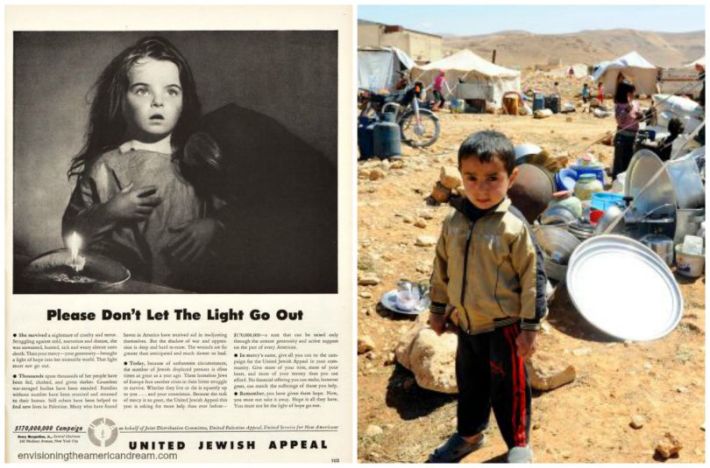
Displaced child of 1947 or 2015 , the call for action is as urgent. According to UN figures the current global levels of displacement have not been matched since WWII. The vintage UJA ad on the left pleads for the displaced persons of WWII. ” These homeless Jews of Europe face another crisis in their bitter struggle to survive,” reads the copy.”Whether they live or die is squarely up to you…and your conscience.” The moral imperative must be there for the Syrian refugees today.
As the late great Yogi Berra might say, it’s Déjà vu all over again.
The heartbreaking stories and pictures of horror and loss experienced by the Syrian refugees, those 4 million men women and children fleeing a homeland riven by more than 4 years of violent civil war, desperate to seek a safe haven, has brought to mind an earlier generations suffering and our own similarly slow response to offer asylum.
The story of WWII’s displaced persons is well worth remembering.
Closed Borders or Open Hearts
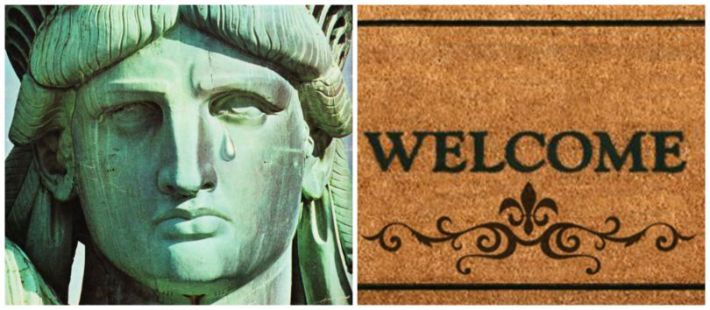
Many Americans are uneasy with the idea of taking in Syrian Refugees and the mounting crisis has become yet another polarizing question in our country. One side says we are doing too little, issuing a call to action to accept more refugees and increase financial aid, while another side fearful of the risk to national security have issued their own call to action – pull up the welcome mat.
American history loves to celebrates our role as a land of asylum, humanity and opportunity for people across the globe. It’s a pillar of our cherished self-image as exceptional among nations.
It’s the American Way.
Whenever tragedy has struck, Americans put out their hands in compassion and help. This is indeed true of America but it is often not achieved without great resistance.
History books often overlook or minimize the contrasting truth – that along with setting out a friendly welcome mat there has always been opposition, reluctance and setbacks to that warm hospitality.
That too is the American Way.
But that America does eventually triumph over these obstacles is all the more powerful because it has been achieved.
It leaves me hopeful about the grave humanitarian crisis we face now, and reflective of what once was.
Displaced Persons

Liberated Jews suffering from illness and exhaustion emerged from concentration camps and hiding places to discover a world which had no place for them. Photo: Displaced Persons 1946
Well into the Post War years , thousands of European Jews remained locked in Displaced persons camps in Germany and Austria. For these ¼ million stateless, homeless Jewish survivors, prospects for resettlement in free democratic lands appeared uncertain.
The conventional wisdom that we immediately opened our shores with outstretched arms to these displaced persons has become a more romanticized version of the truth; the harsh edges of their struggle to enter the land of the free have softened over the past 70 years.
Not unlike today, many Americans were resistant to the idea of welcoming these refugees to our shores.
1945 No Where to Go

Strong national prejudices, procrastination in Congress and some less than dynamic leadership in White House combined to prolong the miseries of Jews who survived the Holocaust.
After World War II ended in May 1945, many of the people who were liberated had nowhere to go.
All over Europe like a great backwash to the tidal wave of war, almost 10,000,000 confused depleted and hungry human beings were wandering from place to place amidst the rubble of war. Some were newly liberated labor slaves, some civilians, some prisoners of war.
Trudging on foot, hitching rides on bicycles, looted German cars, trucks, and hay wagons this stumbling mass of humanity moved steadily on urged on the idea to get home.
For many there was no longer a home.
Many survivors who went home faced hostility from their neighbors and found their homes, possessions and jobs gone.

Displaced persons camp Germany 1946. My future mother in law and her son, my future husband who would spend the first 4 years of his life in a DP camp. Photo: family collection
Braving the incertitude among history’s most jumbled mass of migration was a courageous young Jewish woman grown older than her 23 years through the unspeakable horrors that no one should ever bear witness to.
Her entire family lost at the hands of the Nazis, separated from her husband, she trudged on with her meager belongings tightly clutching her most valued possession, her precious newborn baby.
This tiny baby boy, born without a home, who would never know what it was to grow up with grandparents, uncles or aunts would one day grow up to be my future all-American husband.
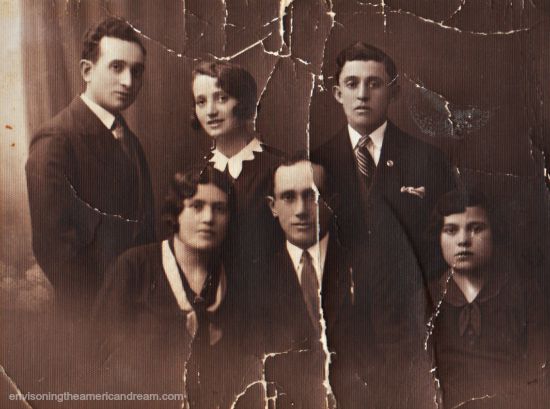
Bereft of home and family, tattered photos were the few remaining mementos many had. Polish Jews 1930s. Vintage photo from family collection
Unable to return to her now vanished hometown in Poland, reunited with her husband, they found their way to a displaced persons camp in Germany.
DP camps were made from abandoned German army barracks, factories and even concentration camps. Most of these camps were crowded and unsanitary with shortages of food and clothing
Before the end of 1945, more than 6 million of those uprooted by the war found a home leaving 1.5 to 2 million displaced persons. Most Jewish survivors were unable or unwilling to return home because of persistent anti-Semitism and the destruction of their communities during the Holocaust. Many of those who did return feared for their lives. In postwar Poland, for example, there were a number of violent riots that claimed scores of Jewish lives.
The big question was where to put the people who could not be repatriated?
Give Us Your Tired, Your Poor

“You’re a Cheap Bunch of Soreheads and You Can’t Land Here,” says a bloated Uncle Sam in cartoonist Art Young’s protest against discriminatory immigration laws. This editorial cartoon appeared in “The Masses” the radical, socialist magazine that attacked the status quo.
Restrictive immigration policies were still in effects in the U.S. and legislation to expedite the admission of Jewish DPs was slow. These constricting immigration policies had at least a partial basis in anti-Semitism and racist theories, thanks to immigration laws passed between 1882 and 1929 that were among the most discriminatory in the world, regulating immigration by race.
Despite loosening of some quota restrictions, by the end of the year opportunities for legal immigration to the United States remained extremely limited.
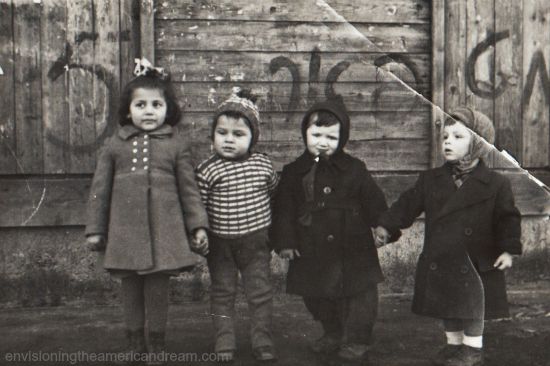
While the arguing went on, so did the suffering. Children in a DP camp in Germany 1947. Photo: family collection
Congressional action was needed before existing immigration quotas could be increased, so while Congress procrastinated and bickered, my husband would spend the first four of his life in a DP camp looking for a country that would accept him.
A Tarnished Golden Door
These Jews did not receive the welcome promised in the poem by Emma Lazarus inscribed on the Statue of Liberty “I lift my lamp beside the Golden door.” In the years following the end of the war, the lamp was dimmed, the door too often closed.
But like today there were pockets of outrage.
Even conservative Henry Luce publisher of Life Magazine took Uncle Sam to task a full year after the ending of the war in an editorial with the headline “Send Them Here.”
“The most shocking fact about the plight of these displaced persons is not that they are interned. It is the fact that the US Government and people have the means to open the door for many of them but have not done so.”….
“Europe’s refugees need a place to go And America needs to set a world example.
More than a year after the crushing of the Nazis there are still some 850,000 people in concentration camps in Germany Austria and Italy. The crime of the inmates is a lack of passport or another place to go
“We have a deep moral obligation not to be too exclusive. The constitution of the UN proclaims the universality of human rights and freedom a clause the US has often invoked. How can we be so complacent in our immigration policy?
“Above all, in Gods name can we go on doing nothing about those DP’s?”
The Jewish Question

“The shadow of war and oppression is deep and hard to erase. The wounds are far greater than anticipated and much slower to heal. These homeless Jews of Europe face another crisis in their bitter struggle to survive,” reads the copy in this Vintage 1947 ad UJA. ” Stretch out your hand in brotherhood, open your heart in compassion.”
While Congress cooled their heels, charitable organizations stepped up, none more so than the United Jewish Appeal.
In the late 1940’s anti-semitism was a prevalent attitude in the US.
In Congress antisemitism was an explaining factor in the common hostility towards refugee immigration and anti-semitism explains Congress action that blocked all likely havens of refugee for the Jews before the War.
Part of that hostility was fueled – as some grievances are now- by stereotypes of the refugees as harbingers of a dangerous ideology, in this case communism.
United Jewish Appeal – Call to Action
The UJA appeal was unprecedented.
The United Nations Relief and Rehabilitation Administration that had started helping DPs in 1945 was saddled with limited resources and inadequate to cope with the tremendous need.
A major campaign by the United Jewish Appeal organized in 1946 to help the Jewish Displaced Persons set in motion the most massive reconstruction and immigration program in Jewish history.
It was a challenge to American Jews to help survivors.
Words spoken at a UJA meeting nearly 70 years ago by Bernard Baruch could just as easily be applied to the Syrian refugees today.
“Added to their physical suffering is their mental anguish for they have become the unwanted – driven from place to place- welcome nowhere.”
Along with thousands of others who answered the humanitarian call, my own family opened their hearts in compassion to help, never knowing that in decades to come this saga would touch their own family.
A Moral Obligation – It’s a Family Affair
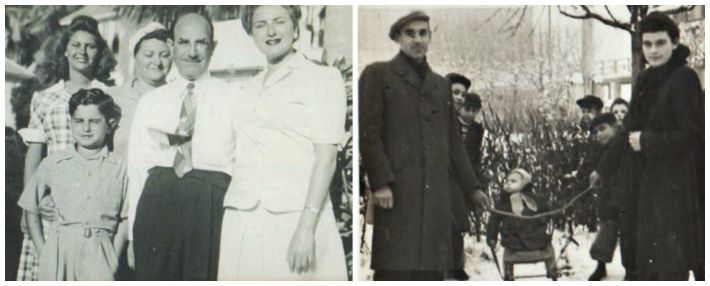
Winter 1946. (L) While my mothers Manhattan family vacationed in Miami Beach , (R) my husband and his family spent the winter in a DP Camp in Germany.
On a snowy February afternoon in 1946 while my future in-laws scrounged for food in a Displaced Persons camp in Germany, bartering cigarettes and chocolate for fresh meat and milk my own beloved grandmother Sadie sat in the warm comfort of the grand ballroom of the Waldorf Astoria Hotel, one of a several hundred women attending the opening rally of The Woman’s Division of the UJA of Greater NY.
Seated at snowy white linen covered tables festooned with silver plated urns filled with Herbert Tareyton cigarettes, they waited silently, somberly sipping tea and nibbling lighter than air angel food cake in anticipation of the featured speaker Mrs Franklin Delano Roosevelt.
We…You…Are Their Only Hope
These ladies had gathered together to embark on the greatest drive to raise money for the Jewish Refugees , part of The UJA’s recently launched $100,000,000 nation wide drive.
Eleanor Roosevelt the guest speaker had just recently come from visiting 4 DP camps and movingly shared her experience of the indescribable pain and suffering she witnessed.
Looking out at the packed ballroom of that grand hotel filled with well-heeled and well-intentioned ladies, a veritable sea of bobbing Lilly Dache chapeau, a profusion of ranch mink and Persian Lamb coats redolent of Shalimar and Joy, the former First lady firmly implored : We cannot live in an island of prosperity in a sea of human misery,
These smartly dressed ladies in their Hattie Carnegie dresses who now lived in large limestone apartments that lined the grand Avenues of the Upper West Side of N.Y. gave her a standing ovation.
“These are Your Brothers and Sister Who Speak…”
Nearly all these women were once Eastern Europeans themselves, or had come from those who had made the odyssey, suffered from dislocation, confusion, fear, loss of what they knew.
All looking for a better life.
Many of these same women knew first hand the Cossack’s on horseback that had driven their people from their homes, the laws that had prevented them from owning land, living where they wanted, getting an education.
They knew that even here, in this new land where they had prospered because prosperity was what America had to offer, they were still despised for being themselves, for being Jews. So they knew the only way to survive was with your people and to care for them.
That it was the obligation of American Jews to contribute generously to relieve the suffering of the surviving Jews of Europe was never in question.
The UJA ran a series of emotion laden ads asking for help, such as the one above.
“Give them Life and Make it Worth Living”
These are your sister and brothers who speak.
Praying that their liberation from Nazi tyranny shall not be turned into a mockery by the worlds indifference. Praying that now, after years of torture and death and a miserable existence in displaced persons camps they be helped to rebuild their lives.
By 1947 the need was greater.
The Jewish population of the DP camps has tripled in one year. From 85,000 at the beginning of 1946 to 250,00 in 1947.
Resources were depleted.
Not only were US Quotas still in place against the Jews there was an organized campaign against permitting the entrance of displaced persons into the U.S. with President Truman’s mail 7 to 1 against admission.
Many nations shared the shame of the US in having refused sanctuary to stateless Jewish survivors following WWII.
Efforts to get them into Palestine faced great odds. Great Britain continued to strictly limit the number of Jews allowed in Palestine. Jews already living in British-controlled Palestine organized “illegal” immigration by ship. In 1947 the British forced the ship Exodus 47 which was carrying 4,500 Holocaust survivors headed for Palestine, to return to Germany where the passengers were again imprisoned in camps.
The United Nations Relief and Rehabilitation Administration set to expire that June placed greater burdens on the agencies of the UJA.
The massive campaign continued running ad campaigns in the popular magazines.
Could You Refuse Them If They Stood Before You?
The plaintive question asked in this 1947 UJA ad went straight to the heart:
“Could you look into the sad proud eyes of this girl and say, No child I will not help you?
Could you bear to hear the sobs of this frightened boy without wanting to draw him into the warm shelter of your s arms?
There are thousands more like these 2…children who have survived Hitlers plan for their extermination. Sad, hungry terrified children who need your help.They have seen sights no child should ever see. They have known terror we in America cannot even imagine. Before they had a chance to be young, their hearts grew old. Their souls are wounded in a way that only understanding people like you can heal.
They need everything. Food clothes and medicine just to keep them alive. The need homes and guidance. They need education and training for useful lives in Palestine the US or some other hospitable land.
But most of all they need what all people need…faith in their fellow beings, hope for the future.
We in America…you in your comfortable living room..it is us they look for help. We…you…are their only hope.
It was a moral obligation then, it is a moral obligation now.
Next: Syrian Refugee Crisis:Deja Vu All Over Again PT II: The Fear Factor
© Sally Edelstein and Envisioning The American Dream, 2015. Unauthorized use and/or duplication of this material without express and written permission from this blog’s author and/or owner is strictly prohibited. Excerpts and links may be used, provided that full and clear credit is given to Sally Edelstein and Envisioning The American Dream with appropriate and specific direction to the original content.






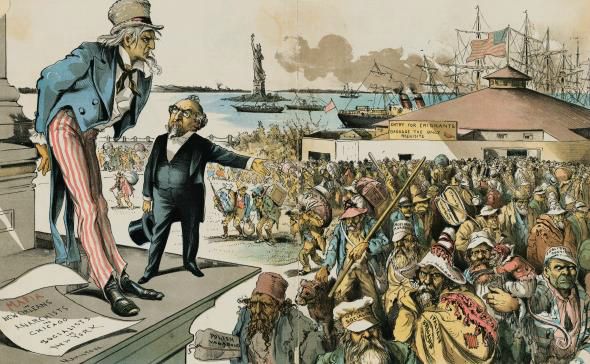
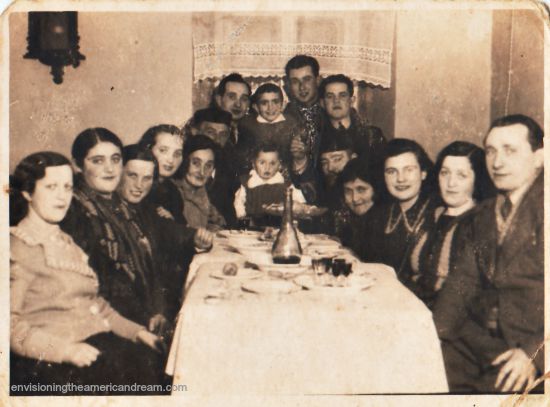
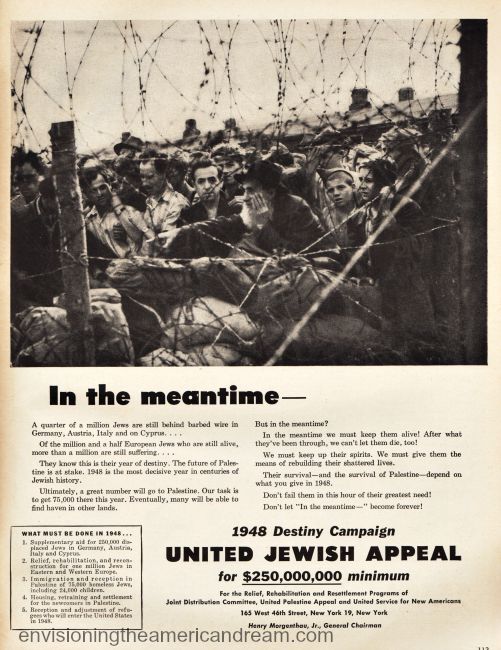
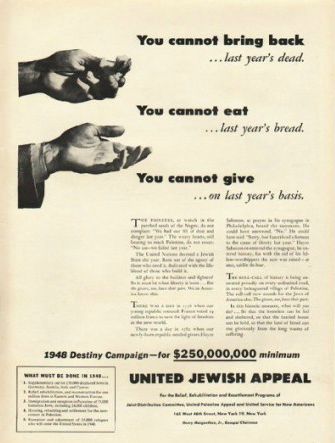






A wonderful humanitarian post Sally. Being a history buff, love the parallels! Have a few other thoughts, but will hold-on to them until Part 2 is posted. 🙂
LikeLike
Thank you, this one was close to my heart. I will look forward to hearing more from you after Pt.II
LikeLiked by 1 person
Americans seem to have a schizophrenic attitude about immigration and immigrants. We like to romanticize about how we welcomed immigrants in the past. You know, that give us your tired, etc. thing. But that is the past. We have a long history of turning away immigrants, such as the Haitians. Or discriminating against the immigrants who managed to make it in, such as the Irish.
LikeLiked by 1 person
Absolutely right
LikeLike
Thank you for this excellent post. Just yesterday I was thinking about how long it’s been since I heard anyone quoting the inscription on the Statue of Liberty (more honored in the breach than in the observance:)
“Give me your tired, your poor,
Your huddled masses yearning to breathe free,
The wretched refuse of your teeming shore.
Send these, the homeless, tempest-tost to me,
I lift my lamp beside the golden door!”
That was the American idea I heard in school.
I also find it odd that Leviticus 19: 33-34 is not much quoted by those who cite Leviticus for other reasons: “…the stranger that dwelleth with you shall be unto you as one born among you, and thou shalt love him as thyself, for ye were strangers once in the land of Eqypt….” I look forward to hearing a “pious” politician quote that…. But I’m not holding my breath….
LikeLiked by 1 person
Wonderful quotes that ought to be referenced and observed more often
LikeLike
Pingback: The Syrian Refugee Crisis – Deja Vu All Over Again Pt II The Fear Factor | Envisioning The American Dream
Pingback: Refugee Crisis – The Fear Factor | Envisioning The American Dream